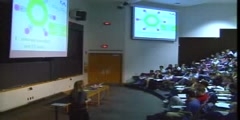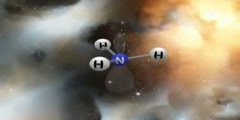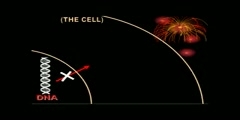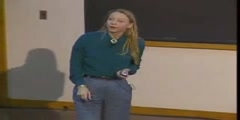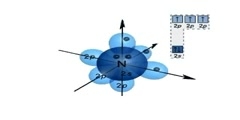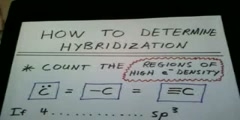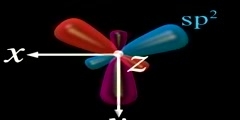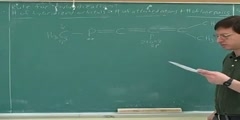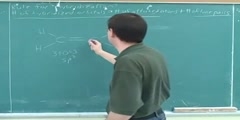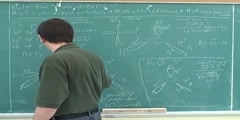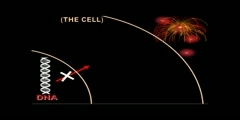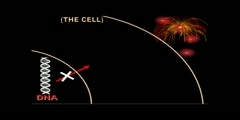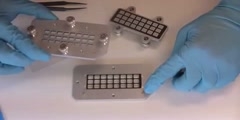Lec 14 - Checking Hybridization Theory with XH_3
"Lec 14 - Checking Hybridization Theory with XH_3" Freshman Organic Chemistry (CHEM 125) This lecture brings experiment to bear on the previous theoretical discussion of bonding by focusing on hybridization of the central atom in three XH_3 molecules. Because independent electron pairs must not overlap, hybridization can be related to molecular structure by a simple equation. The "Umbrella Vibration" and the associated rehybridization of the central atom is used to illustrate how a competition between strong bonds and stable atoms works to create differences in molecular structure that discriminate between bonding models. Infrared and electron spin resonance experiments confirm our understanding of the determinants of molecular structure. 00:00 - Chapter 1. A Relationship between Hybridization and Molecular Structure 08:30 - Chapter 2. Optimizing Hybridization in XH3 Molecules 19:17 - Chapter 3. Infrared Spectroscopy on the Structures of the XH3 Molecules 29:43 - Chapter 4. Electron Spin Resonance on Hybridization and Electron Density Complete course materials are available at the Open Yale Courses website: http://open.yale.edu/courses This course was recorded in Fall 2008.
Video is embedded from external source so embedding is not available.
Video is embedded from external source so download is not available.
Channels: Chemistry (General)
Tags: Umbrella Vibration hybridization radical lone pair electronegativity bond polarity
Uploaded by: yalefreshorganic ( Send Message ) on 05-09-2012.
Duration: 47m 36s
Here is the next lecture for this course
Chemical Science - Hybridization and Chem ...
51:30 | 19706 viewsThe world of hybridization
03:31 | 5555 viewsIn Situ Hybridization
03:15 | 13709 viewsThe valence bond theory
49:54 | 22364 viewsMolecular Shapes And Hybridization
10:10 | 10706 viewsWhat is sp3, sp2, and sp hybridization
09:23 | 10164 viewsHybridization
01:36 | 5684 viewsOrbital hybridization in Sigma and pi bonds
06:33 | 7551 viewsOrbital Hybridization
10:08 | 6673 viewsSigma And Pi Bonds in Orbital Hybridization
10:45 | 6547 viewsIn situ hybridization video in the cell
03:14 | 6287 viewsMicroarray hybridization experiement
01:01 | 5264 viewsIn Situ Hybridization (ISH)
03:14 | 8739 viewsMicroarray hybridization video
01:01 | 10659 viewsMultivariate Multiplex Microarray Hybridi ...
03:27 | 5727 viewsNo content is added to this lecture.
This video is a part of a lecture series from of Yale
Lecture list for this course
Lec 2 - Force Laws, Lewis Structures and Resonance
Lec 3 - Double Minima, Earnshaw's Theorem and Plum-Puddings
Lec 4 - Coping with Smallness and Scanning Probe Microscopy
Lec 6 - Seeing Bonds by Electron Difference Density
Lec 7 - Quantum Mechanical Kinetic Energy
Lec 8 - One-Dimensional Wave Functions
Lec 9 - Chladni Figures and One-Electron Atoms
Lec 10 - Reality and the Orbital Approximation
Lec 11 - Orbital Correction and Plum-Pudding Molecules
Lec 12 - Overlap and Atom-Pair Bonds
Lec 13 - Overlap and Energy-Match
Lec 15 - Chemical Reactivity: SOMO, HOMO, and LUMO
Lec 16 - Recognizing Functional Groups
Lec 17 - Reaction Analogies and Carbonyl Reactivity
Lec 18 - Amide, Carboxylic Acid and Alkyl Lithium
Lec 19 - Oxygen and the Chemical Revolution (Beginning to 1789)
Lec 20 - Rise of the Atomic Theory (1790-1805)
Lec 21 - Berzelius to Liebig and Wöhler (1805-1832)
Lec 22 - Radical and Type Theories (1832-1850)
Lec 23 - Valence Theory and Constitutional Structure (1858)
Lec 24 - Determining Chemical Structure by Isomer Counting (1869)
Lec 25 - Models in 3D Space (1869-1877); Optical Isomers
Lec 26 - Van't Hoff's Tetrahedral Carbon and Chirality
Lec 27 - Communicating Molecular Structure in Diagrams and Words
Lec 28 - Stereochemical Nomenclature; Racemization and Resolution
Lec 29 - Preparing Single Enantiomers and the Mechanism of Optical Rotation
Lec 30 - Esomeprazole as an Example of Drug Testing and Usage
Lec 31 - Preparing Single Enantiomers and Conformational Energy
Lec 32 - Stereotopicity and Baeyer Strain Theory
Lec 33 - Conformational Energy and Molecular Mechanics
Lec 34 - Sharpless Oxidation Catalysts and the Conformation of Cycloalkanes
Lec 35 - Understanding Molecular Structure and Energy through Standard Bonds
Lec 36 - Bond Energies, the Boltzmann Factor and Entropy
Lec Last - Potential Energy Surfaces, Transition State Theory and Reaction Mechanism

